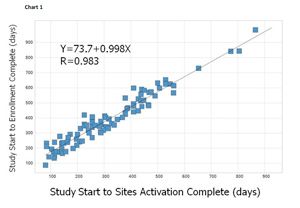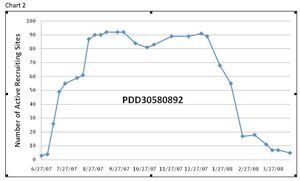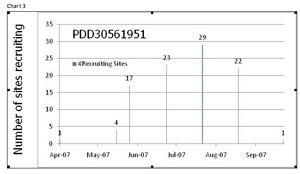Site Activation: The Key to More Efficient Clinical Trials
A new study of hundreds of thousands of clinical trial records reveals that the overall length of a trial is directly related to how long it takes to activate the study sites - and that most companies are wasting precious weeks and even months in activation. Here's how to improve your performance.
Nothing in any other industry quite compares to the pharmaceutical industry’s clinical development process.In 2007, $28 billion dollars were spent on drug development. Nowadays a single clinical trial can be capital intensive (up to $500 million), with massive geographic coverage (as many as 53 countries), long duration (five years or longer), and enroll a large number of patients (20,000- to 50,000-patient trials are no longer rare).
A median Phase III clinical trial involves about 800 patients, 50 investigator sites, and two years (700 days) from First Subject First Visit (FSFV) to Last Subject Last Visit (LSLV). Add in the costs of per-patient medical procedures, drug supplies, laboratory work, and sponsor’s personnel, and a median-sized clinical trial can cost upwards of $25 million, about $36,000 every single day.
Clearly clinical trials are extremely important to the pharmaceutical industry both as the source for clinical data and as an enormous cost center. And the patient enrollment phase of a trial is the most variable part of the process-that is, the spot where we could most reasonably expect to drive down costs. But we still lack a fundamental understanding of patient enrollment as a business process. While many companies are attempting to manage trials better, it is not surprising to see that their approaches, even those of established industry experts, lack in structure and objectivity and occasionally make things worse-for example, by making false assumptions about who has final responsibility for recruiting patients.
Because drug development operations are unusually complex, they cannot easily be handled by applying general operations management principles. There is still a need, however, to introduce quantitative methods to better describe and improve clinical trial execution. Luckily, the industry is becoming increasingly transparent, so that more and more operational data are available for analysis. I have spent the past few years building a database tracking the performance of clinical research sites (collecting 20,000 to 50,000+ site performance data every week). These data point to some strikingly clear directions for improving clinical trial operations.
Site Activation Is the Driver
Patient enrollment, at its simplest, consists of three steps:
- Site selection
- Site activation
- Patient recruitment
Site selection is the process of identifying a sufficient number of and good-quality investigators to conduct the trial. This is one of the greatest challenges in clinical trial execution. You need to find someone with considerable medical skills, commitment to research, good facilities, willingness to fill in endless forms, and last but not least, access to patients who fit the patient selection standard and will agree to enroll.
It takes several steps to bring a site to the point where it is ready to recruit patients. This process is called site activation, and it consists of a variety of tasks including:
- Negotiate a financial contract
- Gain approval from Institutional Review Board (IRB) or, in Europe, Ethics Board (EB)
- Provide clinical supplies
- Obtain other documents from site (CV, financial disclosure, etc)
Though the two activities are entirely different in content, patient recruitment generally occurs simultaneously with site activation. This is partly because clinical trial teams are often not sure they have an adequate number of sites until they come very close to their enrollment target. As a result, they tend to keep activating sites until enrollment is almost complete. Inevitably, recruiting at some sites is shut down within a matter of days, creating ill will and frustration.
By analyzing the data, we can come to several conclusions:
Site activation is the driver in patient enrollment Many in the industry believe that patient enrollment is the responsibility of the investigator sites, and sponsors play only a supporting role in the process. This is only part of the truth.

Chart 1 shows the relationship between investigator site activation cycle time and patient enrollment cycle time, for clinical trials in a particular disease condition. On average, for trials in this disease, time to reach peak number of enrolling sites is 79 percent of the time to complete enrollment. Statisticians tell me I’m not likely to find a much better linear correlation than the one in this chart! This finding validates a previous analysis using an individual company’s internal data, but now the large sample size from multiple sponsors globally provides enough confidence to draw conclusions.
Here’s the truth of the matter: Enrollment cycle time varies by sponsor and disease state, but across disease states, site activation accounts for about 70 percent of enrollment cycle time. Given the near-perfect linear relationship between the two, we can conclude that patient enrollment cycle time is driven by site activation activities. And the site activation process is largely determined by the sponsor. Therefore, patient enrollment is determined by sponsor internal business process, not driven by individual investigator sites.
Theoretically, site activation duration can be reduced to the time needed to activate a single site-100 days on average. (With improved planning and execution, that average can be reduced as well.) Since site activation uses two-thirds of enrollment cycle time, a 50 percent reduction in site activation time would reduce enrollment cycle time by 30 percent. And a 30 percent reduction in the current median enrollment cycle time of 490 days would amount to more than five months. I believe this is a number attractive to anyone in drug development.
The “rescue mission” is the most common way to waste time As expensive and time-sensitive as clinical trials are, you would expect that companies would forecast them accurately to eliminate delays. In fact, 20 to 50 percent of clinical trials will have a “rescue mission,” where new sites are added in order to cure a shortfall in patient enrollments. Obviously these rescue missions increase costs and prolong cycle times.

Chart 2 illustrates a typical Phase III clinical trial recruitment curve. This clinical trial planned to use about 100 sites, and the first site was activated in June 2007. In three months, the sponsor, which is running this trial by itself (as opposed to outsourcing it to a CRO), completed the activation of the sites as originally planned. But that’s also the time the sponsor found out that it would not be able to reach the enrollment target in time with the sites already activated. Another 15 or so sites were added to the pool. Three months later, it reached another peak in the number of sites actively recruiting patients. Enrollment was completed in early April 2008.
It is impressive to activate 100 sites in three months. The sponsor had clearly leveraged its rich experience in this disease condition. But a mismatch between the original number of planned sites and what was actually needed sites cost them about 100 additional days in site activation cycle time, patient enrollment cycle time, and therefore the whole clinical trial duration. That extra 100 days is just about the median time needed to activate a site.
Planning Can Reduce the Number of Investigative Sites

Let’s look at another “typical” clinical trial- a relatively small Phase II trial that I’ve labeled PDD30561951 (Chart 3). The plan was for the trial to include 30 sites enrolling 100 patients. But as the chart shows, the peak number of sites open to enroll patients was 29. Most sites participated in recruitment for less than half the six-month total enrollment period. On average only 16 sites were actively recruiting at any moment.
A useful way to look at the enrollment pattern of this trial is to express it as a ratio of the average number of sites open for recruitment to the maximum number of sites open for recruitment-the Site Effective Index. In the example displayed in Chart 2, the Site Effective Index is 16 (the average number of open number sites) divided by 29 (the maximum number of sites) or 0.54.
Now, let’s look what happens when we take steps to improve the Site Effective Index. Let’s assume that we will still use the same pool of similar-quality investigator sites and that we are able to maintain the same patient recruitment rate of one patient per site per month. We will delay the activation of the first site by one month, to allow the team time for more and better planning. At the same time, we’ll make two significant changes:
First, we will activate all 29 sites in one month-that is, the cycle time from the First Subject First Visit (FSFV) in the first site to the FSFV in the last site will be one month, instead of four-plus months. Accomplishing this is a matter of planning and making adjustments, for example, shipping clinical supplies to European sites before shipping them to US sites. If we have 29 sites open simultaneously and recruiting at a rate of 1 patient per month, we will be able to complete enrollment in 3.5 months (29 sites x 1 patient per site per month x 3.5 month = 102 patients enrolled). Add the one-month site activation, and the total enrollment duration would be 4.5 months, instead of 6 months-a 25 percent reduction! In this case, we achieved a Site Effective Index (SEI) of 0.78.
Second, instead of finishing early, let’s aim to complete in enrollment on the original schedule-in October 2007. With five months of recruiting at a rate of one patient per site per month, we need only 20 sites instead of 29 to recruit 100 patients. At a typical cost of about $20,000 to activate a site and $2,000 per month to maintain one, total savings would exceed a quarter million dollars. Not bad for a relatively small Phase II trial. In this case, we achieved a Site Effective Index (SEI) of 0.83.
Tracking Investigators
The process sounds simple, and in many ways it is. But it is complicated by the harsh reality of clinical trials investigators: They vary wildly in their quality. In a given trial 30 to 70 percent of sites will fail to deliver even a single patient.
What companies need to do (and mostly don’t) is to track in detail their relationship with investigator sites. The dataset should include such items as:
- Past experiences in specific indications to clinical research coordinator, site, and investigator
- Current enrolling trials in specific indications at the site and to the investigator
- Time to site activation for trials recently completed site activation
- Duration of patient enrollment
- Number of patient enrolled in trials completed enrollment
- Category of the investigator site belong to (academic, commercial, and etc)
Frankly, these are known parameters that drive an investigator site’s potential performance. Many people have tried to utilize these parameters to help them to pick sites with better potential to deliver more patients. Their success has been limited because of insufficient data to support any one of these parameters, and more important because of the lacking of structures and/or models to organically coordinate and integrate them.
For example, it appears to be simple and straight forward to predict an investigator site patient enrollment performance by looking at how many patients were enrolled by the site in the past. But that could be misleading, because even for the same disease condition, the ability of a site to enroll patients can be dramatically different if the site participated in trials with different inclusion/exclusion criteria.
With access to data about investigator sites, trial planners can eliminate some of the uncertainty about patient enrollment and optimize site performance. In a recent arthritis trial, for instance, we conducted a head-to-head test of investigator sites selected by traditional method and selected based on past enrollment performance. Sites selected based on past enrollment performance enrolled 17 patients per site, while the sites selected by traditional methods enrolled 7 patients per site. And 89 percent of sites selected based on past enrollment performance enrolled patients, while only 55 percent of the sites selected by traditional methods enrolled patients.
Industry sponsored clinical trials activate 65,000 investigator sites each year, with an apparently upward trend. Assuming that the cost in activate a site is $20,000; every 1 percent reduction in non-performing sites (those activated but not enroll patients) would save the industry $13 million US dollars! As a matter of fact, a better site selection will not only reduce non-performing sites, but also reduce the number of poor performing sites. The accumulative impact would be an increase of average number of patients enrolled per site, therefore a reduction of total number of investigator sites needed. In total, we are talking about a business opportunity of savings potentially exceeding $1 billion US dollars every year.
To learn from our own experience has not been a particular strength for our industry in the past. One of the reasons has been the lack of sufficient data to build a set of reliable set of parameters to plan a new trial. Planners have had to use limited number of internally completed clinical trials in the same disease condition to build an operations plan for a new trial. Today, however, as data become available that will enable rapid, rational site selection, the industry has an opportunity for a great step forward. By combining better designed and implemented site activation, along with data driven site selection, we will be able to reduce costs or shorten cycle time, or even to achieve a combination of both.
Gen Li is former head of R&D Operations for Pharmacia and Pfizer. He is CEO and founder of PhESI Pharmaceutical Pipeline Enhancement Services and can be reached at gen.li@phesi.com.
Addressing Disparities in Psoriasis Trials: Takeda's Strategies for Inclusivity in Clinical Research
April 14th 2025LaShell Robinson, Head of Global Feasibility and Trial Equity at Takeda, speaks about the company's strategies to engage patients in underrepresented populations in its phase III psoriasis trials.
Key Findings of the NIAGARA and HIMALAYA Trials
November 8th 2024In this episode of the Pharmaceutical Executive podcast, Shubh Goel, head of immuno-oncology, gastrointestinal tumors, US oncology business unit, AstraZeneca, discusses the findings of the NIAGARA trial in bladder cancer and the significance of the five-year overall survival data from the HIMALAYA trial, particularly the long-term efficacy of the STRIDE regimen for unresectable liver cancer.
Expanding Immune Response Testing to Support Vaccine Development
April 22nd 2025Nigel McCracken, chief operating officer, Virax Biolabs, discusses the expansion of its ViraxImmune platform into areas such as transplant monitoring, vaccine efficacy, latent virus reactivation, and CAR T cell therapy.